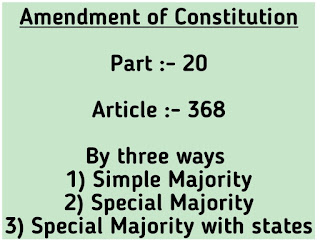Table of Contents
Amendment of the Constitution:-
Today we will discuss thoroughly the important topic of Indian Polity i.e ‘Amendment of the Constitution‘.
Let’s move to some basic information on the Indian Constitution. It has a Preamble, 25 parts, 12 schedules, 5 appendices, 448 articles, and 101 amendments written in about 145000 words. So here the part is we adopted Constitution in 1949 and for the last 75 years we made many changes in it so what is it called. There is a simple word known as “Amendment“.
How is it done?
What is the procedure of amendment?
We will discuss everything in this article of Amendment of Constitution in India.
The Indian Constitution is neither rigid nor flexible. It can be amended while keeping a few restrictions but it is not hard as the USA or not much easy as Britain.
 |
| Amendment of Indian Constitution |
Article 368 of Part 20 deals with the Amendment of the Constitution while power with Parliament. There are three main cases related to the Preamble of the Indian Constitution they are the Berubari Union Case of 1960, the Kesavananda Bharati Case of 1973, and last LIC of India case of 1995 were it was discussed whether the Preamble can be amended under Article 368. Supreme Court, in other words, warned not to amend the basic elements of the Indian Constitution.
The procedure of Amendment of Indian Constitution:-
1) Amendment Bill brought for making changes should strictly be brought in the House of Parliament and not in the state legislature.
2) Bill can be only introduced by a minister or by a private member and does not require the permission of the president.
3) Bill should be strictly passed with a special majority in both houses with 50 % while 2/3 of members present and voting.
4) Each house has to pass the bill separately and in case of differing views between two, there is no provision of holding a joint sitting.
5) If the bill has any provision of federal structure amendment then it must have the permission of half of the states by a simple majority.
6) After passing in both houses of parliament the bill should be sent to the president for assent.
7) President has to sign on it Compulsory. He can’t stop the bill from passing or stop that amendment.
8) After assent of the president, it becomes Act.
Types of Amendment of Indian Constitution:-
Amendment can be done in three different ways
1) Amendment in a simple majority of Parliament.
2) Amendment by a special majority of the Parliament.
3) Amendment by a special majority of Parliament with permission of half of the States legislature.
By Simple Majority of Parliament what can be amended:-
1) Establishment of New small States
2) Formation of new states or changes in boundary and names of states
3) Abolition or establishment of the legislative council in States
4) Salaries of Members of Parliament of Lokshaba and Rajya sabha.
5) Allowance of Members of Parliament
6) Quoram in Parliament
7) Use of English or foreign language in Parliament
8) Official Language decision
9) Citizenship terms of acquisition and termination
10) Union territories
11) Special privileges in Parliament for Members and Committees.
12) The fifth and sixth schedule includes administration of schedule areas, scheduled tribes, and tribal areas.
By Special Majority what can be done:-
This is an important provision in the Constitution and the majority of things need to be amended by Special Majority with 50 % of votes and 2/3 of members present and Voting.
Provisions that can be amended by Special Majority are as follows:-
1) Fundamental Rights
2) Directive Principles of State Policy
3) Other things which don’t come in these two.
By Special Majority of Parliament and consent of States:-
1) Election of President
2) Supreme Court and High Court
3) Distribution of legislative powers between Union and States
4) The executive power of the Union and States
5) List of Seventh Schedule
What is the Constitution in simple Language?
Why was it criticized?
It was criticized due to 3 major reasons. First is that it does not have joint sitting when there is a deadlock between two houses while the ordinary bill has.
This was all about the Amendment of the Indian Constitution which is useful for UPSC and Govt Exams if you have any idea about it or any provision should be added in its comment below. Thanks, Everyone.
JAY HIND…. !!!!

such a great information for blogger i am a information seeker, thanks.
good
grateful to read this, really nice.
Sharma Academy UPSC IAS MPPSC mppsc online coaching classes online mppsc coaching classes
Sharma Academy UPSC IAS MPPSC mppsc online coaching classes online mppsc coaching classes
Sharma Academy Best UPSC, IAS, MPPSC Coaching in Indore Providing MPPSC Notes, Digital Course, Test series, Online Coaching Classes in Indore, Best Coaching For MPPSC in Indore. Sharma Academy is the fastest growing UPSC, IAS, MPPSC coaching classes in indore because our multiple factors are behind our success, we are popular among the student for our classroom programs and mppsc distance learning program is available in many formats like mppsc Table course, mppsc SD Card course and mppsc Pendrive course and having latest mppsc toppers in our team to educate students, Highly experienced and educated faculties staff, Student also can purchase notes, books and MPPSC Online Coaching classes for mppsc published by sharma academy Explanation in very easy language from basic level to high level.